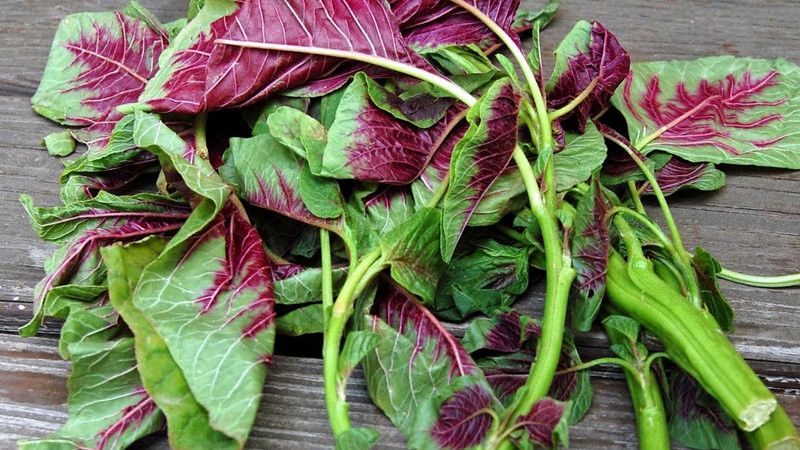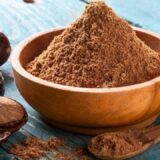Top 10 Health Benefits Of Eating Amaranth Leaves
Amaranthus spinosus Linn. also known as Amaranth is a very popular food crop that is known for its medicinal properties throughout the world.

It is believed to be the oldest food crop that has been cultivation since 6700 BC. It is commonly recognized as thorny amaranth, spiny pigweed, spiny amaranth, or prickly amaranth.
The matured form of Amaranth is also called ‘Amaranth spleen’. It is also one of the popular foods of India, in Hindi, Amaranth is known as Kate wali Chaulai or Kanatabhaji and in Sanskrit, it is called tanduliyaka.
Its leaves once in a while look like spinach, and it is available in red, green, and purple, and golden colors. It is believed that there are more than 70 species of plants throughout the world. Amaranth is known for its amazing source of medicines.
Where Does Amaranth Grow?
The evidence indicates that Amaranth’s origin is South America from Central America to Mexico.
It is believed that shikari (Hunter-gatherers) collected and ate the seeds since pre-historic times; the seeds were also harvested by Aztec and Inca tribes of Central and South America.
The evidence shows that its domestication took place as far back as 4,000 or 5,000 BC. Today Amaranthus spinosus is distributed vastly throughout the tropics and warm temperate regions of Asia.
It is cultivated throughout India, Sri Lanka, and found throughout the tropical zone and warm temperate regions of Asia Indonesia to Japan to the Pacific islands. In Australia, it is cultivated as a weed well and also found in fallow lands.
What Does an Amaranth Plant Look Like?
Amaranth is a green herb that is often called vegetable amaranth it looks like spinach in addition to tasting somewhat spinach-like.
Stems: The stems are normally long upwards, narrow cut. The Grain amaranth plants dicotyledon plants with wide strong stems look similar to those of sunflowers. It can grow up to about 3 to 9 feet tall when mature.
Leaves: The leaves of the Amaranthus plant are varying in size; they may be purple or green, with thin branches. They are usually simple with entire margins, with alternate and distinct marks relating to one species.
Flowers: The flowers are tiny green and are held up in dense generally towards the tips of the branches with elongated clusters. They have a long, soft feather look which is pink, green, white, or purplish in Colour.
Seed: The seeds are generally small and shiny black; it differs to those of grain types, which are yellowish-white. The tiny round shape seeds are mostly pale in color, have up to 3000 seeds per gram.
Another Name For Amaranthus
English: Prickly Amaranth, Needle burr, Spiny amaranth, Thorny amaranth
Hindi: Kanta chaulai, Chaulai, lal sag
Gujarati: Kantalo dhimdo, Kantanu dant
Manipuri: Chengkruk
Marathi: Kante bhaji, kante math, Shavrani math
Tamil: Mullukkeerai
Malayalam: Kattumullenkeera
Telugu: Mullatotakura
Kannada: Mulluharive soppu
Bengali: Kantanotya
Oriya: Kantaneutia
Sanskrit: Tanduliuyah
Kashmiri: Bustan afroz, mawal
Punjabi: Taj khurus
Urdu: Gulkesh
Tamil: Punkirai
Telegu: Chilaka thotakoora
Uses Of the Amaranthus Plant In Ayurveda
- Digestible
- Laxative
- Diuretic
- Stomachic
- Antipyretic
- Improves appetite
- Biliousness
- Blood diseases
- Burning sensation
- Leprosy
- Bronchitis
- Piles
- Leucorrhoea
What is Amaranthus Extracted Used For?
- Anti-inflammatory properties
- Hematology
- Immunomodulatory activity
- Anthelmintic properties
- Antidiabetic
- Antihyperlipidemic
- Spermatogenic
- Immune-stimulating activity
Types of Amaranth Grown in India
Presently, Amaranth is recognized in three subgenera with around more than 70 species, although species numbers are doubtful, it is due to the hybridizing of species in different climates and areas.
1. Amaranth Vridis: It is the most common variety that is found all over India it is also called “green amaranth” and “slender amaranth.”
2. Amaranth Paniculatus: This type of plant is also called the “autumn palette,” it is due to its gorgeous colors of gold with rust and delicate orange.
3. Amaranth Caudatus: It is also known as “love lies bleeding” it is due to its red color flower that looks beautiful overhanging inflorescences.
4. Amaranth Tricolor: This type is named “tricolor leaves” as it has leaves that are reds, yellows, and green colors.
5. Amaranth Hypochondriacus: It is also known as “Prince of Wales Feather” it is due to its decorative look. It has tall, thin, spiky inflorescences. Mostly, this type of plant originates in Mexico, but it is found throughout the Himalayas region.
6. Amaranth Spinosus: This type of plant is also called “prickly amaranthus” and “spiky amaranthus” it is due to its small thorny bush on the stem.
7. Amaranth Cruentus: It is a green variety of plants that may sometimes appear in beautiful shades of cinnamon, purple, red, and ginger.
Top 10 Medicinal Uses of Amaranth
Whole parts of the plant are known to contain therapeutic active ingredients. In Ayurvedic text, the uses of Amaranthus spinosus Linn’s plant is very well mentioned it is used for the treatment of malaria.
Besides this, it is also used for abdominal pain, dysentery, chickenpox, dysuria, fever, hysteria, vomiting, mania, tonsillitis, etc. Besides this, it also has many medicinal uses and benefits below are some of them.
1. Boost Weight Loss Naturally
Eating amaranth grains and leaves can help you stay true to your weight-loss goals. It is because amaranth is loaded full of vitamins, it is a diet that releases a specific “sated” hormone that suppresses the appetite.
Besides this, the dietary fiber is also bulky in your stomach so decreases your appetite. This way, it decreases the temptation to snack between meals that cause you to gain those extra pounds.[1]
2. Control Cause of Birth Defects
Consuming Amaranth can be beneficial to overcome a birth defect’s problems. Vitamin “Folate” or “Vitamin B9” is often neglected in terms of basic minerals, but it is very important for pregnant mothers.
Folate vitamin deficiency can result in neural tube defects in newborns. A number of researchers also believe amaranth can prevent certain birth defects, especially folate inadequacy as it has an ample source of vitamins and minerals.
Amaranths have high sources of vitamin A and carotenoids that are known to enhance eye health and keep off visual abnormalities such as cataracts and macular degeneration. It is an important source of protein that can be used as an alternative to animal-based protein, which is higher in fat.
3. Increase Protein Content
This is indeed the most well-known aspect of amaranth that causes it such a wonderful food source for so many people around the world. It had a high-protein concentration; it helps the body can break the plant proteins down into functional amino acids and be reformed into working proteins.
Proteins are essential for the growth, the creation of new cells and tissues. It also provides the energy needed for metabolic function. Amaranth consists of higher protein compactness than any other grain availed in the market.[2]
4. Improve Digestive Health
Eating amaranth can benefit the most from people having gastrointestinal problems. As it is rich in high-fiber content, it enables to smooth digestion of food and promotes efficient ingestion of minerals.
Moreover, amaranth is also a gluten-free substance that means it can be beneficial for the millions of people suffering from gluten intolerance or with celiac diseases. Amaranth in addition can be the best alternative as a grain source.[3]
5. Improves Varicose Veins
It is a type of condition that may not affect everyone’s person, but varicose veins can be ugly and uncomfortable as we grew older. Amaranth contains countless flavonoids, including rutin, which can help in eliminating varicose veins by strengthening capillary walls.
Besides this, amaranths also have high compactness of vitamin C that can aid an integral component in the production of collagen, which may be helpful to repair and strengthen blood vessel walls.
6. Boost Hair Health
If you are beauty conscious, and want to look after the morality and appearance of your hair consuming amaranth can be best for you. The amaranth consists of a rare amino acid called “lysine” which our body cannot produce naturally.
This amino acid helps to boost your calcium intake efficiency and helps to strengthen follicles, preventing male pattern baldness. Using amaranth for hair is quite simple, just remove the juice from the leaves and apply it to your hair, it will not only strengthen your hair but also prevent hair loss.
7. Increase Antioxidant levels
These days most people rely on antioxidants to be fit and healthy for those amaranths can be the best choice. As amaranth is high-protein content, it makes it an important natural nutrient source for people.
Some modern research indicated that amaranth also contains a certain peptide alike which is identified in soybeans, which has the ability to reduce inflammation in the body. It even prevents the activeness of free radicals that can cause healthy cells to evolve into cancerous cells.
It is one of the most exciting new developments in recent amaranth research that people are unaware of. These anti-inflammatory properties of amaranths can be helpful to people to diminish conditions like gout, arthritis, and other inflammation-related problems.
8. Increase Bone Growth
Calcium is an important mineral that is necessary for the growth of bone and Amaranth leaves contain a wide range of minerals, including calcium. There are very few leafy vegetables that hold higher levels of calcium than amaranth.
So it can be a regular superfood that can help to boost bone strength and prevent problems related to osteoporosis. To be active and healthy calcium is a crucial mineral that prevents demineralization of the bones so consume amaranth daily and live a long life.
9. Improve Cardiovascular Health
In this modern world, cardiovascular disease has become most common it sometimes results in a heart attack. Amaranth can play an important role in reducing these problems.
Amaranths have dietary fiber that can help to balance cholesterol within the body by eliminating “bad” cholesterol from the cardiovascular system. Additionally, amaranth contains an enormous amount of vitamin K; which is a well-known booster for heart health.
It also has potassium content that can help to lower blood pressure by expanding the blood vessels and lowering the strain on the cardiovascular system, thereby lowering the chances of developing coronary artery disease. Moreover, Amaranth has a high content of phytotrons that can contribute to the reduction of “bad” cholesterol.
10. Improves Eye Vision
Lutein is an antioxidant that is responsible for eye tissue and is related to better vision. Amaranth holds in Lutein, which is good for your eyes. In a study, it was found that consuming food containing Lutein can help to protect against the two common age-related eye disorders such as macular degeneration.
Lutein, carotenoid, and zeaxanthin form the yellow pigment in the retina and absorb blue light, an unhealthy element of sunlight. The significant level of carotenoids, vitamin A, vitamin C, beta-carotene, and Lutein found in amaranth leaves can be a major boost for eye health.
FAQ’s
1. What is amaranth?
Amaranth is a group of plants known for their nutritious seeds and edible leaves. It has been cultivated as a grain for thousands of years and is considered a pseudocereal due to its nutritional profile similar to true cereals like wheat and rice.
2. What are the nutritional benefits of amaranth?
Amaranth is rich in protein, dietary fiber, vitamins (such as vitamin A, vitamin C, and some B-vitamins), and minerals (including calcium, iron, magnesium, phosphorus, and potassium). It also contains essential amino acids, making it a valuable source of protein for vegans and vegetarians.
3. How is amaranth consumed?
Amaranth seeds can be cooked similarly to rice or quinoa, making them a great alternative to traditional grains. The cooked seeds have a slightly nutty flavor and a chewy texture. Amaranth leaves can be eaten raw in salads or cooked like spinach or other greens.
4. Is Amaranth gluten-free?
Yes, amaranth is naturally gluten-free, making it a suitable grain for people with celiac disease or gluten sensitivity.
5. Can amaranth help with weight loss?
Amaranth’s high protein and fiber content can promote feelings of fullness and satiety, potentially aiding in weight management by reducing overall calorie intake.
6. How can I store amaranth seeds and flour?
To maintain freshness, store amaranth seeds and flour in airtight containers in a cool, dry place. This will help prevent spoilage and preserve the nutritional value.
For most people, amaranth is safe to eat. However, some individuals may be allergic to amaranth, and it’s advisable to consult a healthcare professional if you suspect an allergy. Additionally, oxalates are naturally present in amaranth leaves, which may be a concern for people with a history of kidney stones or certain health conditions. Cooking the leaves can help reduce oxalate levels.
8. Can amaranth be used in baking?
Yes, amaranth flour can be used in baking to create gluten-free goods like bread, muffins, and pancakes. It’s often used in combination with other gluten-free flour for better results.
9. Is Amaranth environmentally friendly?
Amaranth is considered a sustainable crop because it requires less water compared to traditional grains like wheat and rice. It also grows well in diverse climates, making it a versatile and adaptable option for sustainable agriculture.
Remember, before making significant changes to your diet or if you have specific health concerns, it’s always best to consult with a qualified healthcare professional or a registered dietitian.
Consumption of amaranth can good for living healthy life as it contains various types of vitamins and mineral. People suffering from kidney stones or gallstones should avoid eating as it is high in oxalic acid that could worsen the condition.
References:
- The Dual Nature of Amaranth—Functional Food and Potential Medicine(1)
- Amaranth(2)
- Current knowledge on Amaranthus spp.: research avenues for improved nutritional value and yield in leafy amaranths in sub-Saharan Africa(3)
























